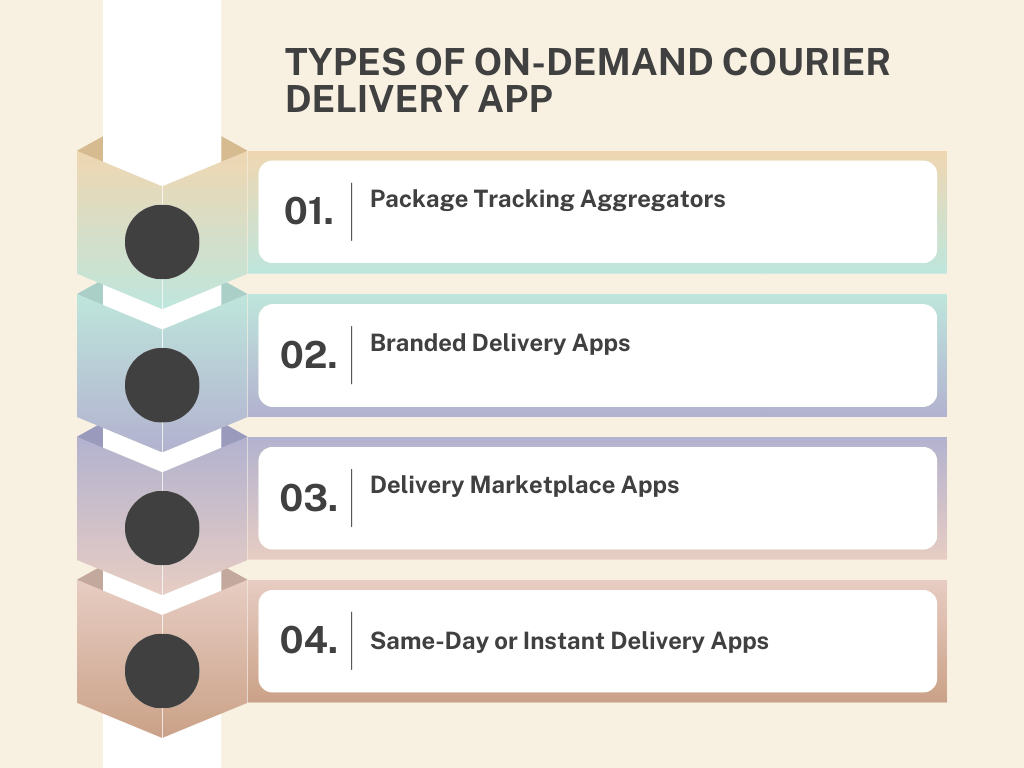With the rapid expansion of the on-demand economy, mobile delivery solutions have become highly attractive for entrepreneurs aiming to build scalable businesses and generate significant revenue.
The emergence of on-demand delivery apps has transformed the logistics landscape, offering real-time tracking, automated dispatching, and user-centric experiences. These platforms replace traditional manual workflows with smart, automated systems that significantly enhance operational efficiency and customer satisfaction.
At its core, the success of any digital product depends on the tangible value it delivers. Courier delivery apps offer transparency, convenience, and flexibility, key drivers behind their rapid adoption and growing market demand.
This comprehensive guide outlines how to bring your courier app idea to life, from must-have features and tech stacks to costs and development strategies, so your business can thrive in this booming sector.
What is a Courier Delivery App?
An on-demand courier delivery app is a mobile platform that connects users with local delivery professionals in real time. These applications enable customers to schedule pickups, track deliveries, and complete secure payments—all from their smartphones.
Whether delivering food, important paperwork, or large parcels, courier apps streamline the entire logistics process using GPS, smart routing, and automated dispatch. Many of these solutions now integrate with food delivery apps, eCommerce systems, and business tools to serve both individuals and enterprises efficiently.
How Does It Work?
Here’s a typical user flow for an on-demand courier app:
- Account Creation: The sender signs up or logs in to the application.
- Enter Package Details: The Sender inputs the recipient information and parcel dimensions.
- Cost Estimation: The app calculates a delivery fee and expected delivery time.
- Payment: Users are taken to the checkout screen to pay securely.
- Courier Assignment: A delivery agent is automatically dispatched to pick up the package.
- Real-Time Tracking: Both sender and recipient can monitor the package’s journey.
- Confirmation & Feedback: Delivery is confirmed, and users can rate their experience.
These platforms also include feedback channels for handling complaints, inquiries, or suggestions.
The Rise of Online Package Delivery Apps
The global market for online courier and delivery apps is witnessing explosive growth. Industry reports suggest that the on-demand logistics sector will exceed $600 billion by 2027, fueled by eCommerce expansion, demand for instant service, and advanced logistics technology.
While giants like FedEx and DHL have developed robust mobile platforms, the market still offers plenty of room for startups and a capable mobile app development company to introduce niche services with a unique value proposition.
Types of Courier Delivery Apps
Selecting the right type of app is critical for aligning your product with user needs and business goals. Below are the most common models:

1. Package Tracking Aggregators
Allow users to track shipments from multiple logistics providers in one place for convenience and centralized oversight.
2. Branded Delivery Apps
Built for a single company, these apps manage the entire logistics cycle internally. Companies like DHL use this model to maintain brand consistency.
3. Delivery Marketplace Apps
These connect users with a pool of independent couriers or freelance delivery professionals. They offer flexible, often crowd-sourced delivery solutions.
4. Same-Day or Instant Delivery Apps
Focused on ultra-fast, local deliveries, these apps are ideal for urgent shipments such as documents, groceries, or hot meals.
Essential Features for Courier Delivery App Development
To compete with leading platforms, your app should include features optimized for each type of user:
1. User Panel
- Simple package booking
- Live tracking of courier location
- Fare estimation before checkout
- In-app payment options
- Push notifications and order updates
- Ratings and feedback system
2. Courier/Delivery Agent Panel
- Job notifications and status updates
- Integrated navigation and optimized routes
- Earnings tracking and wallet access
- Communication tools for customer support
3. Admin Dashboard
- Manage users, couriers, and deliveries
- View detailed analytics and reporting
- Monitor live delivery operations
- Handle payments, promotions, and disputes
To further improve accessibility and scalability, consider integrating multi-language and multi-currency support early in development.
Benefits of On-Demand Courier Delivery Apps
A well-built courier app offers measurable benefits to both businesses and users:
- Faster Deliveries: Real-time dispatch and tracking systems allow for rapid delivery fulfillment.
- Increased Efficiency: Automated logistics reduce human error and administrative overhead.
- Customer Retention: Consistent, reliable service builds loyalty over time.
- Scalable Operations: Expand into new markets or service categories easily.
- Data-Driven Insights: Performance metrics help fine-tune service quality and efficiency.
Steps to Develop a Courier Delivery App
Follow these steps to transform your idea into a high-performing product:
1. Conduct Market Research
Analyze competitors, user pain points, and industry trends. Identify a clear value proposition for your app.
2. Choose the Right Tech Stack
Select technologies based on performance, scalability, and platform preference. Use iOS app development and Android app development approaches if building for both platforms natively.
3. Design Intuitive UI/UX
Prioritize a user-friendly interface that supports fast bookings, easy navigation, and clear package tracking.
4. Develop and Test the MVP
Build a minimum viable product with essential features. Conduct comprehensive testing for functionality, performance, and device compatibility.
5. Launch and Improve
Deploy with a well-planned marketing strategy. Use feedback and analytics to guide ongoing updates and improvements.
Collaborating with an experienced on-demand app development company ensures a smoother and more efficient development cycle.
Recommended Tech Stack for Courier App Development
Here’s a common stack used by modern app developers for courier platforms:
- Frontend: React Native, Flutter (for cross-platform development)
- Backend: Node.js, Python, Laravel (for server-side operations)
- Database: MongoDB, PostgreSQL (for flexible and scalable data management)
- Cloud & Hosting: AWS, Google Cloud (for reliable infrastructure)
- Push Notifications: Firebase, OneSignal (for alerts and engagement)
- Payments: Stripe, Razorpay, PayPal (for secure transactions)
How Much Does It Cost to Build a Courier Delivery App?
App development costs can vary depending on several factors:
- Feature complexity (basic vs advanced)
- Platform count (Android, iOS, web)
- Design quality and UI customization
- Location and experience of the development team
Estimated Development Costs:
- MVP Version: $10,000 – $25,000
- Full-Featured App: $30,000 – $100,000+
Working with a reliable app development company helps you manage timelines, optimize costs, and ensure quality throughout the process.
Final Thoughts
As industries like eCommerce, retail, and logistics continue to evolve, courier delivery apps represent a strategic investment for forward-thinking businesses. Whether you’re a startup exploring your first courier app idea or an enterprise looking to digitize operations, building a high-quality delivery solution positions your brand for success in the fast-moving digital economy.
Let your journey begin with a trusted development partner who understands your vision and helps turn it into a powerful, user-friendly reality. Sparx IT Solutions, a mobile app development company, with long experience in the industry, has worked with leading companies in creating on-demand apps.
You can consult with our experts on discussing your mobile app idea because the roadmap to a successful business app begins with a productive project discussion.

Partner with Experts
Frequently Asked Questions
How On-Demand Courier Delivery App Different from Traditional Logistics?






Traditional logistics depend on manual scheduling and limited tracking, causing delays and less transparency. On-demand courier apps use automation and real-time GPS to provide faster, flexible, and more transparent deliveries.
Who Should Consider Using an On-Demand Courier Delivery App?










An on-demand courier delivery app is a versatile solution that serves a wide range of industries. Businesses such as eCommerce platforms, retail stores, pharmacies, restaurants, legal firms, and logistics companies can all benefit from faster delivery cycles and improved customer satisfaction.
What Tech Stack Is Best for an On Demand Courier Delivery App?










Selecting the right tech stack is crucial for building a scalable and high-performance courier app. Here’s a widely used configuration:
- Frontend: React Native or Flutter
- Backend: Node.js, Python, or Laravel
- Database: MongoDB or PostgreSQL
- Push Notifications: Firebase Cloud Messaging
What Are the Challenges in Building a Courier Delivery App?










Developing an on-demand courier delivery app comes with several technical and operational hurdles, including:
- Real-time Tracking
- Secure Payments
- User Experience
- System Coordination


